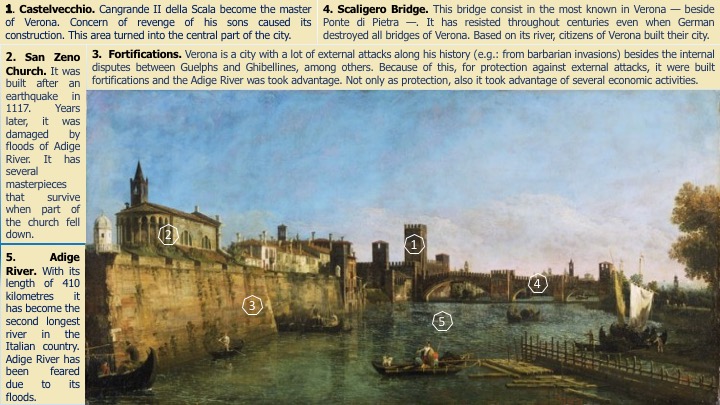This work of art is an artistic painting of the Italian urban landscape painter Bernardo Belloto. Bernardo Belloto was an apprentice in his uncle’s workshop. In 1738 he was enrolled in the guild of painters. Along his life he represented many cities until being recognized as a master of perspective. This masterpiece was taken over the Adige River of Verona between 1745-1746 and shows several places of the Italian city of Verona. This work of art is painted with oil on canvas and it is currently in the Philadelphia Museum of Art.
Verona is located in the North of Italy over the Veneto region. It is the biggest and most prosperous city of the region. It is bordered by Adige River and it is strategically connected with Central Europe due to Brenner Pass through the Alps. Besides being an important crossroad, its history has been highlighted because of knitting, paper, machinery and footwear production. At least, its economic sources have been —besides previously named— the craftwork and trade. Cause of the benefit of these communication roads, Verona turned into a Roman township loved by politician and general Julius Caesar, as well as the architect, writer, engineer and treatise writer Marcus Vitruvius, the historian Gaius Valerius Catullus, and many others. The city construction was focused around this stretch of the river and it turned out in an important source of economic activities like fishing. In the 18th Century there were a lot of fish population, especially, the trout. Moreover, as the painting shows, in the right side appears not building areas in which Verona citizens performed these economic activities but, nowadays, this area has been built and its natural zones have been changed by other buildings.
Previously called San Martin Castle, in the centre of the painting we could find the Corso Castelvecchio. Because of Verona was a strategical city and it received so many attacks, Castelvecchio was built in 1354-55 by Cangrande II della Scala for internal and external protection —especially on the west side—. Years later Napoleon built a fort in the Castelvecchio’s courtyard. Of a time to this part, Castelvecchio has been restored. The first restoration was among 1923 and 1926 when Napoleonic fort acquired a new architectonical aspect. The next restoration was among 1958 and 1964 when the castle recovered its original form in several places. And the last and very recent restoration was finished in 2007. This restoration has improved the capacity of touring the castle through its 27 artistic rooms.
Nevertheless, on the left part we could find San Zeno in Oratorio Church. This church was made in Romanesque style but the facade represents a posterior type of architecture: the Gothic one. Also the painting represents a bridge which is a perfect masterpiece of medieval engineering. It is called Ponte Scaligero (Scaligero Bridge) and it was destroyed in some extension. This bridge is part of Castelvecchio and also was built with military objectives in the middle of fourteenth century (1355 A.D.).
As a Roman city, Verona is based on a regular morphology. Verona citizens took advantage of Adige River for better protection. In the 18th century, the current “historical centre” is the part compound of castles, churches, etc., where lived main powerful people and the poor and peripheral area was the right side of Adige River. In time, the old city of Verona has increase their urban areas so their structure has been enlarged. However, their small historical centre which has inspired so many dramatist, like William Shakespeare with his “Romeo and Juliet”, maintains the charm of centuries behind.
Víctor Lizana Muñoz
Guardar

